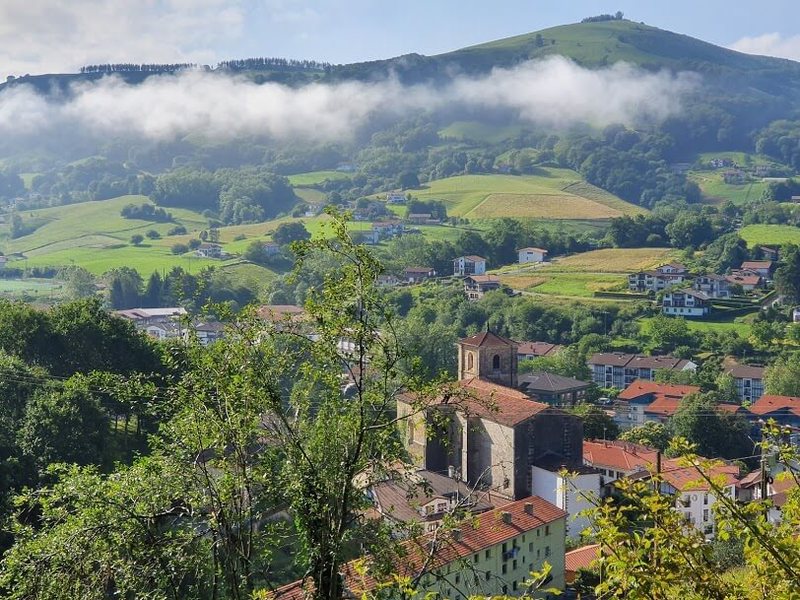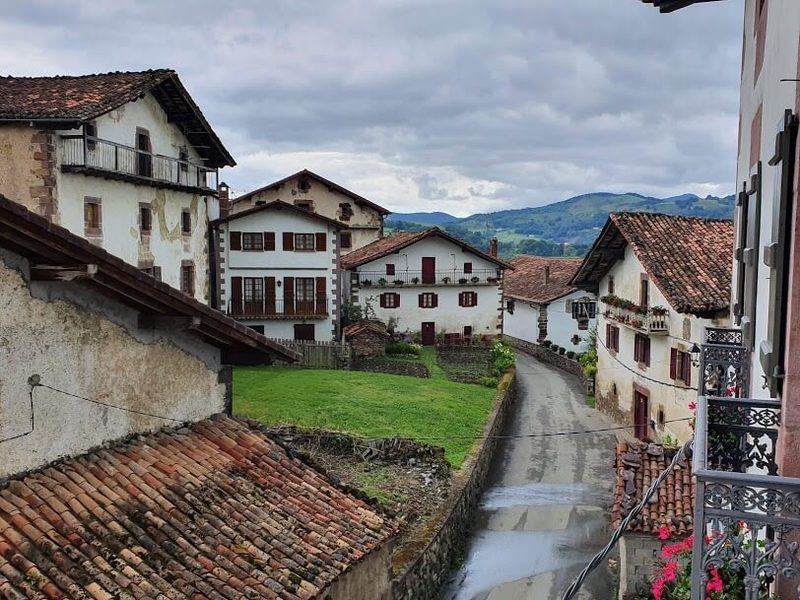If you’re wondering where all the Xs and Zs have gone, look no further than the Basque Country. But apart from being rewarding for Scrabble lovers, the region offers mountains – the western edge of the thrilling Pyrenees – landscapes and a coastline that are also heaven for walkers.
 We have just got back from On Foot Holidays’ rather epic adventure to this beguiling north-east corner of Spain, also straddling the south-west edge of modern France.
We have just got back from On Foot Holidays’ rather epic adventure to this beguiling north-east corner of Spain, also straddling the south-west edge of modern France.
The trip is structured to give you a fascinating insight into Basque history, culture, food and people, alongside a challenging walk through timeless rural mountain communities down towards the Atlantic waves pounding the coastline.
The ‘Basque Country’ applies to the territory of the Basques from historical, cultural and language perspectives. Today it is divided into three distinct entities:
- The Basque Autonomous Community, also known as ‘Euskadi’ (in Spain)
- The Chartered Community of Navarre (in Spain)
- Iparralde (across the border in France)
On Foot’s Basque Pyrenees route is cleverly designed to offer glimpses of each of three Basque territories, starting in Navarre, crossing briefly into Iparralde before a memorable finale in Euskadi, at the foodie paradise of San Sebastian.
 The walk starts from the tiny village of Ziga, where the church bells fight with birdsong to disturb the rural peace. And the beautiful, traditional Zigako Etxezuria sets the standard for accommodation you’ll stay in along the way. Furnished with rustic wooden artefacts and adorned with books and chunky pieces of burnished wooden furniture, this charming Guest House is the perfect introduction to Basque culture, cuisine and hospitality.
The walk starts from the tiny village of Ziga, where the church bells fight with birdsong to disturb the rural peace. And the beautiful, traditional Zigako Etxezuria sets the standard for accommodation you’ll stay in along the way. Furnished with rustic wooden artefacts and adorned with books and chunky pieces of burnished wooden furniture, this charming Guest House is the perfect introduction to Basque culture, cuisine and hospitality.
Homemade paté, vegetable soup served in a patterned teacup, a superbly simple salad, a yummy stew of cod, prawns, potatoes, tomato and onion, and a local goats curd with honey were all washed down by a bottle of Belate red wine from nearby Pamplona.
The full 7 day route covers 13-24 km every day, walking for approximately 4.5-6.5 hours each day – excluding refreshment stops and bird of prey distractions – but there are always options for flexibility, including the chance to travel in the taxi with your luggage if you want to opt out completely one day.
 After Ziga you’ll overnight in traditional towns and villages in the mythical Baztan Valley – Elizondo, Arizkun, Etxalar and Bera – before reaching the coast. At each of these, after a rewarding day walking through lush green meadows, through shady ancient beech woods and over scintillating Pyrenean peaks, you’ll have time to explore communities seemingly unchanged for generations.
After Ziga you’ll overnight in traditional towns and villages in the mythical Baztan Valley – Elizondo, Arizkun, Etxalar and Bera – before reaching the coast. At each of these, after a rewarding day walking through lush green meadows, through shady ancient beech woods and over scintillating Pyrenean peaks, you’ll have time to explore communities seemingly unchanged for generations.
After the remoteness of the mountains, the coastline inevitably means more infrastructure and people. But reaching the most south-westerly French town of Hendaye – scene of a meeting between Franco, Hitler and von Ribbentrop in 1940, aimed at persuading Spain to join the Axis powers – before hopping over the Bidasoa estuary into Spain, discovering Hondarribia and the mediaeval fishing village of Pasaia before the final thrilling descent into San Sebastian, all combine to make this stretch feel like a separate adventure.
You’ll uncover something special every day, but here are a few personal highlights – from many – to give a flavour of what you might expect:
Wildlife
The sound of bells clanging from the necks of cows or horses in rolling green pastures is often the only sound you’ll hear in the mountains, together with occasional birdsong. And make sure you look up frequently, to try and catch sight of soaring kites or griffon vultures.
On day 2 of the walk, descending from Mount Alba towards the tiny hamlet of Gartzain, we spotted a few large birds circling, then diving into a field to the left of our path. By the time we reached the village, there were dozens of majestic griffon vultures circling, as if in a Heathrow holding pattern, but then swooping down towards a barn in a quiet farmyard.
Hondarribia
 Beautiful Girona in Catalonia is often called ‘a mini Barcelona’. We left Hondarribia, across the mouth of the Bidasoa – and the border – from Hendaye, thinking it might be a quieter version of better known San Sebastian.
Beautiful Girona in Catalonia is often called ‘a mini Barcelona’. We left Hondarribia, across the mouth of the Bidasoa – and the border – from Hendaye, thinking it might be a quieter version of better known San Sebastian.
What a delightful surprise this place is, one of Spain’s most historic towns but one I’m ashamed to say I hadn’t heard of before. With a long seafaring tradition and a captivating walled old town, it has been declared a Historic Artistic Site. Would that we had stayed here more than one night….we will return.
Pelota
Each community in the Baztan Valley, however small, seems to have a partly open, cavernous space at its heart, with a wall – a fronton – at one end. These are the venues to play the traditional Basque sport of pelota, either with bare hands or with a basket or racquet, two teams of two smashing the hard, rubberised ball against the fronton, scarily close to the heads of the two competitors nearer the wall.
The On Foot booklet gives a fascinating insight into the history of this Basque tradition. It’s humbling to see it being played everywhere with such passion, seemingly also a place for whole communities to congregate.
San Sebastian
Donostia, as Basques call San Sebastian, is the perfect place to rest weary legs and reward hungry mouths after your epic walk from the Pyrenean foothills to the coast.
 Check in to the superb Hotel de Londres y de Inglaterra, stroll along the magnificent promenade encircling the perfect sandy arc of Playa de la Concha and hit the renowned pintxos bars in the narrow cobbled streets of the Parte Vieja. Graze on bite-sized portions of spectacular local ingredients, and wash them down with a few glasses of txakoli, a slightly sparkling, very dry white Basque wine. You’ll have earned it.
Check in to the superb Hotel de Londres y de Inglaterra, stroll along the magnificent promenade encircling the perfect sandy arc of Playa de la Concha and hit the renowned pintxos bars in the narrow cobbled streets of the Parte Vieja. Graze on bite-sized portions of spectacular local ingredients, and wash them down with a few glasses of txakoli, a slightly sparkling, very dry white Basque wine. You’ll have earned it.
And before you jump back on the plane, a visit to the San Telmo Museum is a fitting finale to this holiday. Here, at the foot of Urgull hill and in a superbly designed building combining a 16th century Dominican convent with contemporary concrete and angles, spend a few hours discovering more about Basque history, culture and arts.
On Foot Holidays
It is hard to overstate the quality of travel experience that On Foot Holidays provide, if you decide to walk this superb route.
 Whichever option you choose is self-guided, but it will feel as though On Foot are with you every step of the way. On-the-ground support is offered by friendly and professional Aznar Fernández de Pinedo. Each overnight stay has been chosen with careful consideration. The famous ‘blue book’ contains much more colour than I can offer in this brief article, providing information on local history, culture, the economy, architecture, language and practical advice on transfer options, what to take, and eating out options.
Whichever option you choose is self-guided, but it will feel as though On Foot are with you every step of the way. On-the-ground support is offered by friendly and professional Aznar Fernández de Pinedo. Each overnight stay has been chosen with careful consideration. The famous ‘blue book’ contains much more colour than I can offer in this brief article, providing information on local history, culture, the economy, architecture, language and practical advice on transfer options, what to take, and eating out options.
And for each day, you will have meticulous step-by-step directions from On Foot, together with maps of the route. Combine that with the waymarks etched on rocks, trees, signposts and buildings and you won’t stray far from this rewarding new route.











